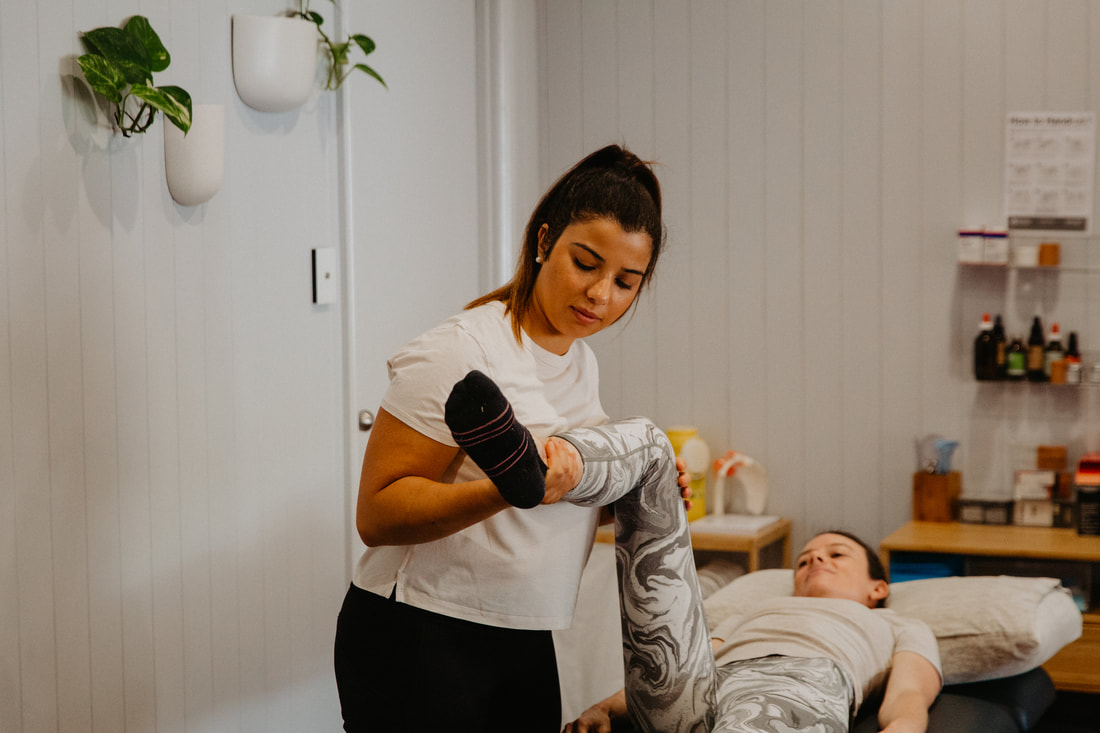Hip pain physiotherapy Brisbane southside.
Hip pain is a common complaint that can be caused by a variety of factors, ranging from overuse injuries to structural abnormalities in the hip joint. Pain in the hip can greatly impact your ability to carry out everyday activities such as walking, running, and climbing stairs, as well as interfere with your quality of life. As physiotherapists, we specialize in the assessment, diagnosis, and treatment of hip pain, and we are here to help you regain function and alleviate your pain.
Our team of experienced physiotherapists use evidence-based techniques to help identify the underlying cause of your hip pain and develop a personalized treatment plan that meets your specific needs. We take a holistic approach to care, addressing not just the local structures in and around the hip but also considering referral pain from other regions of the body that can contribute to hip pain.
Our goal is to provide you with the tools you need to manage your pain, improve your function, and enhance your quality of life. Whether you are an athlete dealing with a hip injury or an individual experiencing hip pain due to daily activities, we are committed to helping you achieve your goals and get back to doing what you love.
Osteoarthritis
Osteoarthritis is a degenerative joint disease that commonly affects the hip joint. It occurs when the protective cartilage that cushions the joint breaks down over time, leading to pain, stiffness, and limited range of motion. Osteoarthritis typically develops gradually and is more common in older adults, although it can also occur in younger individuals who have experienced trauma or repetitive stress on the joint. Common symptoms of hip osteoarthritis include pain in the groin or thigh, stiffness in the hip joint, and difficulty with activities such as walking, bending, or climbing stairs. Treatment for osteoarthritis typically involves a combination of exercise, weight management, pain management, and joint protection strategies.
Bursitis
Bursitis is a condition that occurs when the small, fluid-filled sacs known as bursae become inflamed. The bursae are located throughout the body, including in the hip joint, and act as cushions between bones, tendons, and muscles. When the bursae become irritated, it can cause pain and tenderness in the hip joint. Common causes of hip bursitis include repetitive stress on the joint, injury, or underlying medical conditions such as rheumatoid arthritis. Symptoms of hip bursitis may include pain in the outer hip, tenderness when pressing on the affected area, and swelling. Treatment for hip bursitis typically involves rest, ice, pain management, and physical therapy to address any underlying muscle imbalances or weaknesses that may be contributing to the condition.
Labral tears
The labrum is a ring of cartilage that surrounds the hip socket, helping to provide stability and support to the joint. Tears in the labrum can occur due to injury, repetitive motions, or wear and tear over time. Symptoms of a labral tear may include pain in the hip joint, a clicking or catching sensation when moving the hip, or stiffness in the joint. Treatment for a labral tear may include rest, pain management, physical therapy to address any underlying muscle imbalances, and in some cases, surgery to repair or remove the damaged tissue.
Hip fractures
Hip fractures are a serious injury that can occur in the femur or the pelvis. They most commonly occur in older adults with weakened bones, although they can also occur due to trauma or repetitive stress on the joint. Symptoms of a hip fracture may include severe pain in the hip or groin, difficulty moving the affected leg, and swelling or bruising around the joint. Treatment for a hip fracture typically involves surgery to repair or replace the damaged bone, followed by a period of rest and rehabilitation.
Piriformis syndrome
Piriformis syndrome is a condition that occurs when the piriformis muscle in the buttock becomes tight or spasms, compressing the sciatic nerve that runs from the lower back down through the leg. Symptoms of piriformis syndrome may include pain in the hip and buttock region, tingling or numbness in the leg, and difficulty sitting or standing for extended periods. Treatment for piriformis syndrome may include stretching and strengthening exercises, massage, and pain management techniques.
Sacroiliac joint dysfunction
The sacroiliac joint (SIJ) is located where the sacrum (the triangular bone at the base of the spine) meets the pelvis. Dysfunction in this joint can cause pain in the lower back and hips. The pain can be caused by a variety of factors, including injury, inflammation, and degenerative conditions. Symptoms of SIJ dysfunction include pain in the lower back, buttocks, and hips, as well as stiffness and a reduced range of motion in the hips. The pain can be felt on one side or both sides of the body, and can be aggravated by activities such as standing, walking, or climbing stairs. Physiotherapy treatment for SIJ dysfunction can include manual therapy, exercise, and education on proper movement patterns to reduce pain and improve function.
Pelvic Floor Referral
The pelvic floor is a group of muscles that support the bladder, uterus, and rectum. Dysfunction in these muscles can cause pain in the hip area, as well as other symptoms such as urinary and fecal incontinence. Pelvic floor referral pain can occur due to overuse, weakness, or tension in the muscles. Symptoms of pelvic floor referral pain include pain in the hip and groin area, as well as pain during intercourse, urination, or bowel movements. Treatment for pelvic floor referral pain may include pelvic floor muscle training, manual therapy, and education on proper posture and breathing techniques.
Testicular Referral
Testicular referral pain occurs when pain is felt in the hip area, but is actually originating from the testicles. This can be caused by a variety of factors, including infection, injury, or nerve damage. Symptoms of testicular referral pain include pain in the hip and groin area, as well as swelling and tenderness in the testicles. Treatment for testicular referral pain will depend on the underlying cause, but may include medication, surgery, or physiotherapy to address any associated musculoskeletal issues.
In summary, hip pain can be caused by a variety of factors, including local structural issues such as gluteal tendinopathy and femoroacetabular impingement, as well as referral pain from other areas such as the SIJ, pelvic floor, and testicles. A physiotherapist can help to assess and treat the underlying cause of hip pain, using a variety of techniques including manual therapy, exercise, and education. If you or a loved one are suffering with hip pain, come in and see our friendly Coorparoo and Tarragindi physiotherapists today! Call us on 07 3706 3407 or email [email protected] for a booking. We would love to work with you.
Our team of experienced physiotherapists use evidence-based techniques to help identify the underlying cause of your hip pain and develop a personalized treatment plan that meets your specific needs. We take a holistic approach to care, addressing not just the local structures in and around the hip but also considering referral pain from other regions of the body that can contribute to hip pain.
Our goal is to provide you with the tools you need to manage your pain, improve your function, and enhance your quality of life. Whether you are an athlete dealing with a hip injury or an individual experiencing hip pain due to daily activities, we are committed to helping you achieve your goals and get back to doing what you love.
Osteoarthritis
Osteoarthritis is a degenerative joint disease that commonly affects the hip joint. It occurs when the protective cartilage that cushions the joint breaks down over time, leading to pain, stiffness, and limited range of motion. Osteoarthritis typically develops gradually and is more common in older adults, although it can also occur in younger individuals who have experienced trauma or repetitive stress on the joint. Common symptoms of hip osteoarthritis include pain in the groin or thigh, stiffness in the hip joint, and difficulty with activities such as walking, bending, or climbing stairs. Treatment for osteoarthritis typically involves a combination of exercise, weight management, pain management, and joint protection strategies.
Bursitis
Bursitis is a condition that occurs when the small, fluid-filled sacs known as bursae become inflamed. The bursae are located throughout the body, including in the hip joint, and act as cushions between bones, tendons, and muscles. When the bursae become irritated, it can cause pain and tenderness in the hip joint. Common causes of hip bursitis include repetitive stress on the joint, injury, or underlying medical conditions such as rheumatoid arthritis. Symptoms of hip bursitis may include pain in the outer hip, tenderness when pressing on the affected area, and swelling. Treatment for hip bursitis typically involves rest, ice, pain management, and physical therapy to address any underlying muscle imbalances or weaknesses that may be contributing to the condition.
Labral tears
The labrum is a ring of cartilage that surrounds the hip socket, helping to provide stability and support to the joint. Tears in the labrum can occur due to injury, repetitive motions, or wear and tear over time. Symptoms of a labral tear may include pain in the hip joint, a clicking or catching sensation when moving the hip, or stiffness in the joint. Treatment for a labral tear may include rest, pain management, physical therapy to address any underlying muscle imbalances, and in some cases, surgery to repair or remove the damaged tissue.
Hip fractures
Hip fractures are a serious injury that can occur in the femur or the pelvis. They most commonly occur in older adults with weakened bones, although they can also occur due to trauma or repetitive stress on the joint. Symptoms of a hip fracture may include severe pain in the hip or groin, difficulty moving the affected leg, and swelling or bruising around the joint. Treatment for a hip fracture typically involves surgery to repair or replace the damaged bone, followed by a period of rest and rehabilitation.
Piriformis syndrome
Piriformis syndrome is a condition that occurs when the piriformis muscle in the buttock becomes tight or spasms, compressing the sciatic nerve that runs from the lower back down through the leg. Symptoms of piriformis syndrome may include pain in the hip and buttock region, tingling or numbness in the leg, and difficulty sitting or standing for extended periods. Treatment for piriformis syndrome may include stretching and strengthening exercises, massage, and pain management techniques.
Sacroiliac joint dysfunction
The sacroiliac joint (SIJ) is located where the sacrum (the triangular bone at the base of the spine) meets the pelvis. Dysfunction in this joint can cause pain in the lower back and hips. The pain can be caused by a variety of factors, including injury, inflammation, and degenerative conditions. Symptoms of SIJ dysfunction include pain in the lower back, buttocks, and hips, as well as stiffness and a reduced range of motion in the hips. The pain can be felt on one side or both sides of the body, and can be aggravated by activities such as standing, walking, or climbing stairs. Physiotherapy treatment for SIJ dysfunction can include manual therapy, exercise, and education on proper movement patterns to reduce pain and improve function.
Pelvic Floor Referral
The pelvic floor is a group of muscles that support the bladder, uterus, and rectum. Dysfunction in these muscles can cause pain in the hip area, as well as other symptoms such as urinary and fecal incontinence. Pelvic floor referral pain can occur due to overuse, weakness, or tension in the muscles. Symptoms of pelvic floor referral pain include pain in the hip and groin area, as well as pain during intercourse, urination, or bowel movements. Treatment for pelvic floor referral pain may include pelvic floor muscle training, manual therapy, and education on proper posture and breathing techniques.
Testicular Referral
Testicular referral pain occurs when pain is felt in the hip area, but is actually originating from the testicles. This can be caused by a variety of factors, including infection, injury, or nerve damage. Symptoms of testicular referral pain include pain in the hip and groin area, as well as swelling and tenderness in the testicles. Treatment for testicular referral pain will depend on the underlying cause, but may include medication, surgery, or physiotherapy to address any associated musculoskeletal issues.
In summary, hip pain can be caused by a variety of factors, including local structural issues such as gluteal tendinopathy and femoroacetabular impingement, as well as referral pain from other areas such as the SIJ, pelvic floor, and testicles. A physiotherapist can help to assess and treat the underlying cause of hip pain, using a variety of techniques including manual therapy, exercise, and education. If you or a loved one are suffering with hip pain, come in and see our friendly Coorparoo and Tarragindi physiotherapists today! Call us on 07 3706 3407 or email [email protected] for a booking. We would love to work with you.
Who to book in with:
Yulia Khasyanova
|
Emma Cameron
|
Monica Hanna
|



